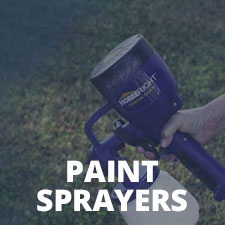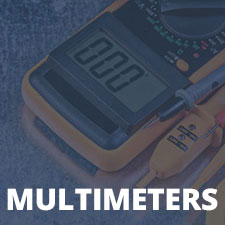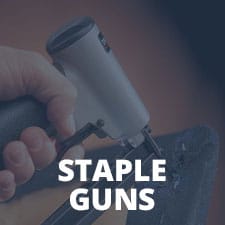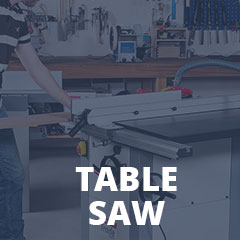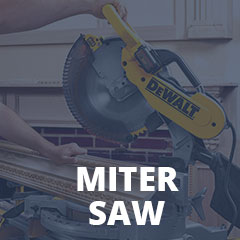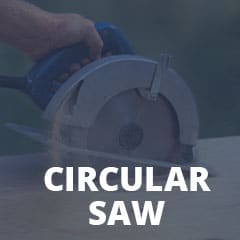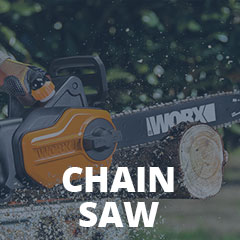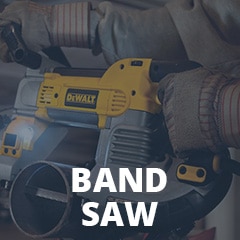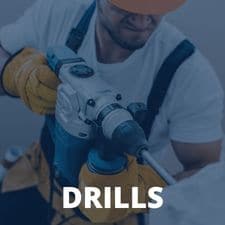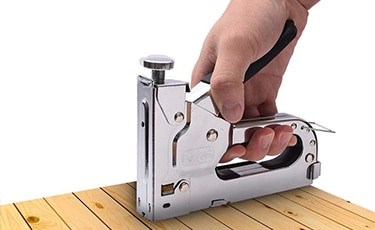
A staple gun for wood is an extremely popular and useful piece of equipment with a multitude of applications in your home or workshop — from upholstering and furniture repairs, to joinery and framing.
However, being able to drive metal fasteners with significant force — they require careful operation. Not just to ensure that you achieve the project results you demand, but also to safeguard your wellbeing and that of friends, pets, and family.
In this comprehensive guide, I’ll cover how to use staple gun by focusing on the crucial dos and don’ts. And remember, although different from a nail gun — as you can see in our informational article here — its safety and handling rules are very similar.
Before starting on your next stapling project, check out this simple how-to guide to make sure that you’re being safe and knowledgeable at all times.
Here are the dos and don’ts of staple guns!
How Does a Staple Gun Work?
Before I go through how to use a staple gun correctly — it’s helpful if you understand a little about how a staple gun works.
Staple guns for wood are available in three main formats — manual, electric, and pneumatic. However, whether you’re using brute force, electrical, or air power — their internal method of operation is virtually identical.
When you squeeze the trigger (manual) or press the button (electric and pneumatic), you’re loading two internal metal bars with potential force. When they reach their manufacturer-determined load limit, they release — which drives a metal shaft onto a single staple and propels it into your target material.
While manual units are the most affordable type, they lack the grunt of electric machines and the ultimate brawn of pneumatic guns.
The Dos and Don’ts of a Staple Gun for Furniture and Wood
DO NOT: Use a Staple Gun Without Protection
Perhaps the most important of all the precautionary measures when using staple guns.
Just like we mentioned in our table saw safety tips article, you should never use staple guns for wood without wearing the proper protection.
I recommend putting on a pair of impact-resistant eyewear glasses before turning on your staple gun. Since stapling or upholstering your furniture requires you to get up close and personal with your work, your eyes are only inches away from this powerful, fast-acting tool. You must stay protected or risk losing your vision.
When the staples shoot out, they’re determined to punch the first thing they come in contact with. If you’ve been in the furniture industry for a while, you know how permanent those staples can be once they’ve made it to their destination. Stapling yourself in the eye is quite an unappealing experience, to put it mildly.
Furthermore, put on a pair of slim yet durable protective gloves. You never know when you’ll accidentally drop the gun and send a staple flying somewhere it shouldn’t be going.
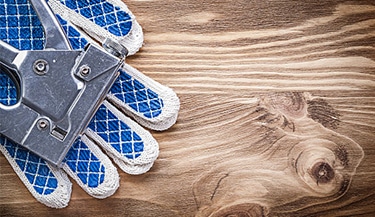
DO: Use Dry and Clean Air to Power the Wood Staple Gun
If you utilize a pneumatic stapler for wood — always use clean and dry compressed air.
Contaminated air or other gaseous materials can make a variety of events happen — from breaking the gun to causing an explosion. No amount of safety gear would be able to protect you from that!
Stay away from the following materials when powering your pneumatic staple gun for wood:
DO NOT: Point the Wood Staple Gun at Yourself or Anyone Else
There’s a reason why these tools are referred to as guns, they act in the same way as a handheld weapon — using a compression and release system to rapidly shoot out a projectile at powerful speeds.
This is what creates such a brawny and permanent impact once the staple reaches its target.
You should always keep the gun pointed downwards and away from yourself, pets, and others. This is most crucial while using a pneumatic machine and connecting the air compressor to the gun before use. Do not take its safety mechanisms for granted — you never know when you may accidentally shoot out a staple.
The best way to get into the habit of practicing staple gun safety is to treat it as if it were a real gun — such as a Smith & Wesson Model 10. You may have heard the phrase, always assume the gun is loaded. The same is true for a wood stapler gun. Don’t play around with it or point it where it shouldn’t be — even if it is turned off, the safety is on, or you think it isn’t loaded.
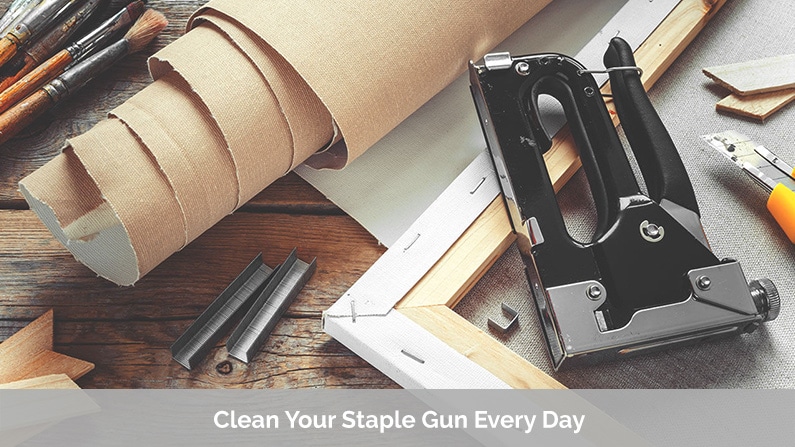
DO: Inspect Your Staple Gun Before Use
DO NOT: Use the Wood Staple Gun if a Part Isn’t Working
As a follow-up to the previous section, if during your inspection you find that some of the parts aren’t working, you should immediately send it in for repair or replacement. Do not attempt to use your staple gun if there are inoperable parts.
That said, some smaller issues can be resolved without recourse to a stapler engineer — check out my Solving Staple Problems guide.
An inspection includes:
● Seeing if the trigger, safety, and staple gun springs are working correctly.
● Listening for unusual noises or clicking sounds.
● Watching to see if the gun acts abnormally when you attempt to use it.
If you find an issue, it’s better to not risk your safety. Turn the gun off, disconnect its parts, and get it fixed as soon as possible.
DO: Fire Staples Into Wood
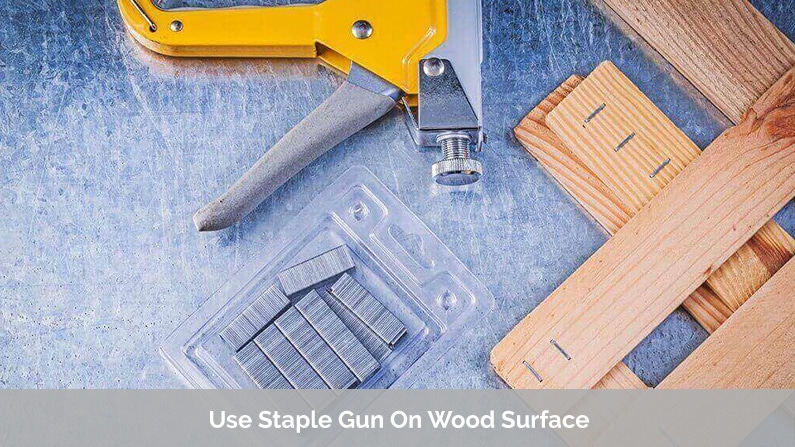
DO NOT: Use the Staple Gun as a Hammer
DO: Read the Manufacturer’s Instructions
DO NOT: Use an Incorrect Staple Type
Conclusion — Take These Tips to Heart!
Our Tool Nerds team is passionate about helping you make the right choices and find the correct tools and equipment for your favorite projects. We know how popular and versatile machines like staple guns are — and we want to make sure that you’re staying safe at all times!
If you enjoyed this Staple Gun for Wood Dos and Don’ts — DON’T keep it all to yourself — DO share it with your buddies. And, if you’re interested in learning more about staple guns, check out our other staple gun articles. Now you’re well on your way to building some great pieces of furniture!
Staple Gun — How To Use Dos and Don’ts FAQs
Q: Can You Use a Regular Stapler on Wood?
No. Office staplers lack the brawn to penetrate wood. Furthermore, their staples are designed to fasten paper — they will buckle and bend trying to drive into timber. In short, you will damage your stapler, the staples, and your target material.Q: How To Use a Staple Gun For Upholstery Safely?
My four top tips on how to use staple gun safely for upholstery applications are:- Always check the gun is working correctly before use.
- Fit compatible staples into the staple gun.
- Wear protective equipment.
- Never point the staple gun at yourself or others.
Q: How To Use a Staple Gun Safely on Metal?
Staple guns are designed for use on textiles and wood — not metal. If you need to attach metal — use screws, bolts, or rivets.Q: What Are Some Staple Gun Uses?
Staple guns can be used for a plethora of applications, including:- Attaching insulation.
- Securing wiring.
- Building furniture.
- Reupholstering.
- Hobby crafting.
- Modeling.

